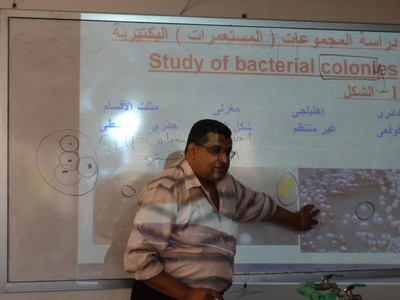استخدام حمض الهيوميك وبعض المخصبات الحيوية لخفض معدلات التسميد النيتروجيني للخيار وعلاقة ذلك بالنمو الخضري والمحصول والتحليل الكيماوي

رضا عبد الخالق الشبرواي*، عبد المنعم يوسف رمضان* وشريف محمد القاضي**
* معهد بحوث البساتين – مركز البحوث الزراعية
** كلية الزراعة – جامعة دمياط
تم تنفيذ تجربتين حقليتين خلال الموسمين الصيفيين 2007 و 2008 على محصول الخيار
هجين أميرة II في مزرعة محطة بحوث البساتين بقها محافظة القليوبية لدراسة استخدام حمض الهيوميك (إضافة أرضية – بدون إضافة) وكذلك تلقيح النباتات ببكتريا الأزوتوباكتر والأزوسبيريلليم مع إضافة مستويات مختلفة من التسميد النيتروجيني الكيماوي (30 ، 60 ، 90 كجم ن/فدان بالإضافة إلى معاملة الكنترول (نباتات غير ملقحة ومسمدة بـ 120 كجم ن/فدان) وتأثير ذلك على النمو الخضري والمحصول والتحليل الكيماوي.
ويمكن تلخيص النتائج المتحصل عليها فيما يلي:
<!--الإضافة الأرضية لحمض الهيوميك بتركيز 0.5 % بمعدل 25 مل للنبات مرتين بعد 36 ، 50 يوم من الزراعة أدى إلى زيادة النمو الخضري والمحصول ومحتوى أوراق الخيار من النيتروجين والفوسفور والبوتاسيوم زيادة معنوية في كلا الموسمين ولم يتأثر محتوى الثمار من النترات معنوياً بإضافة حمض الهيوميك.
<!--أوضحت النتائج أن تلقيح نباتات الخيار ببكتريا الأزوتوباكتر بمعدل 25 مل/النبات بعد شهر من الزراعة بالإضافة إلى التسميد بـ 90 كجم ن/ الفدان أعطى أعلى القيم لجميع الصفات المدروسة.
<!--أثر التفاعل بين حمض الهيوميك وتلقيح النباتات ببكتريا الأزوتوباكتر مع التسميد النيتروجيني معنويا على جميع الصفات المدروسة.
وعلى ذلك يمكن التوصية بإضافة حمض الهيوميك كإضافة أرضية بتركيز 0,5% بمدل 25 مل للنبات بعد 36 ، 50 يوم من الزراعة بالإضافة إلى تلقيح النباتات ب 25 مل من بكتريا الأزوتوباكتر مع تسميد نباتات الخيار بـ 90 كجم ن/الفدان وذلك للحصول على أعلى محصول وجودة مع تقليل التأثير الضار للأسمدة النيتروجينية حيث كان محتوى الثمار من النترات في الحدود الآمنة للإنسان.
قام بتحكيم البحث
|
أ.د / سمير طه محمود العفيفى |
كلية الزراعة – جامعة المنصورة |
|
أ.د / يوسف طلعت امام الليثى |
مركز البحوث الزراعية |
USE OF HUMIC ACID AND SOME BIOFERTILIZERS TO REDUCE NITROGEN RATES ON CUCUMBER (Cucumis sativus L.) IN RELATION TO VEGETATIVE GROWTH, YIELD AND CHEMICAL COMPOSITION.
El-Shabrawy, R. A.*; A.Y. Ramadan* and Sh. M. El-Kady**
*Vegt. Ras. Dept., Hort. Res. Inst., Agric. Res. Center, Giza.
**Microbiology Dept., Fac. of Agric., Damiatta University.
ABSTRACT
Two field experiments were carried out during the two summer seasons of 2007 and 2008 at Kaha Hort. Res. Station, Kaliobia Governorete. Humic acid and Azotobacter and Azospirillum as bacteria fixing nitrogen along with nitrogen levels 30, 60 and 90 kg N/fed. plus uninoculated plants were evaluated under recommended N dose 120 kg N/fed., in addition to their interaction on growth, yield and chemical composition of cucumber plants. A split plot design with three replicates was used. The results revealed that, humic acid at 0.5 % as soil application increased the vegetative growth expressed as number of leaves, plant height (cm), plant fresh and dry weight (gm) and leaf area (cm2) and increased significantly fruits/plant, plant yield (kg/fed.) Early and total yield (ton/fed.).
Also, soil application of humic acid at 0.5 % had significant effect on nitrogen, phosphours and potassium. However, NO3 in cucumber fruits was not significantly affected with humic acid.
Biofertilizers (Azotobacter and Azospirillum as bacteria fixing nitrogen had a significant on all studied character in both seasons, the highest values were obtained by inoculation cucumber plants with Azotobacter and 90 kg N/fed.
The interaction between humic acid and biofertilizers plus nitrogen levels had significant effect on all treats under study in both seasons.
Generally, it could be concluded that, soil application of humic acid at 0.5% twice after 36 and 50 day after sowing at rate 25 ml/plant and inoculation plants with Azotobacter after 30 day after sowing at rate 25 ml/plant along with 90 kg N/fed gave the highest values of yield and NO3- concentration on cucumber fruits were within the safe levels from human



ساحة النقاش